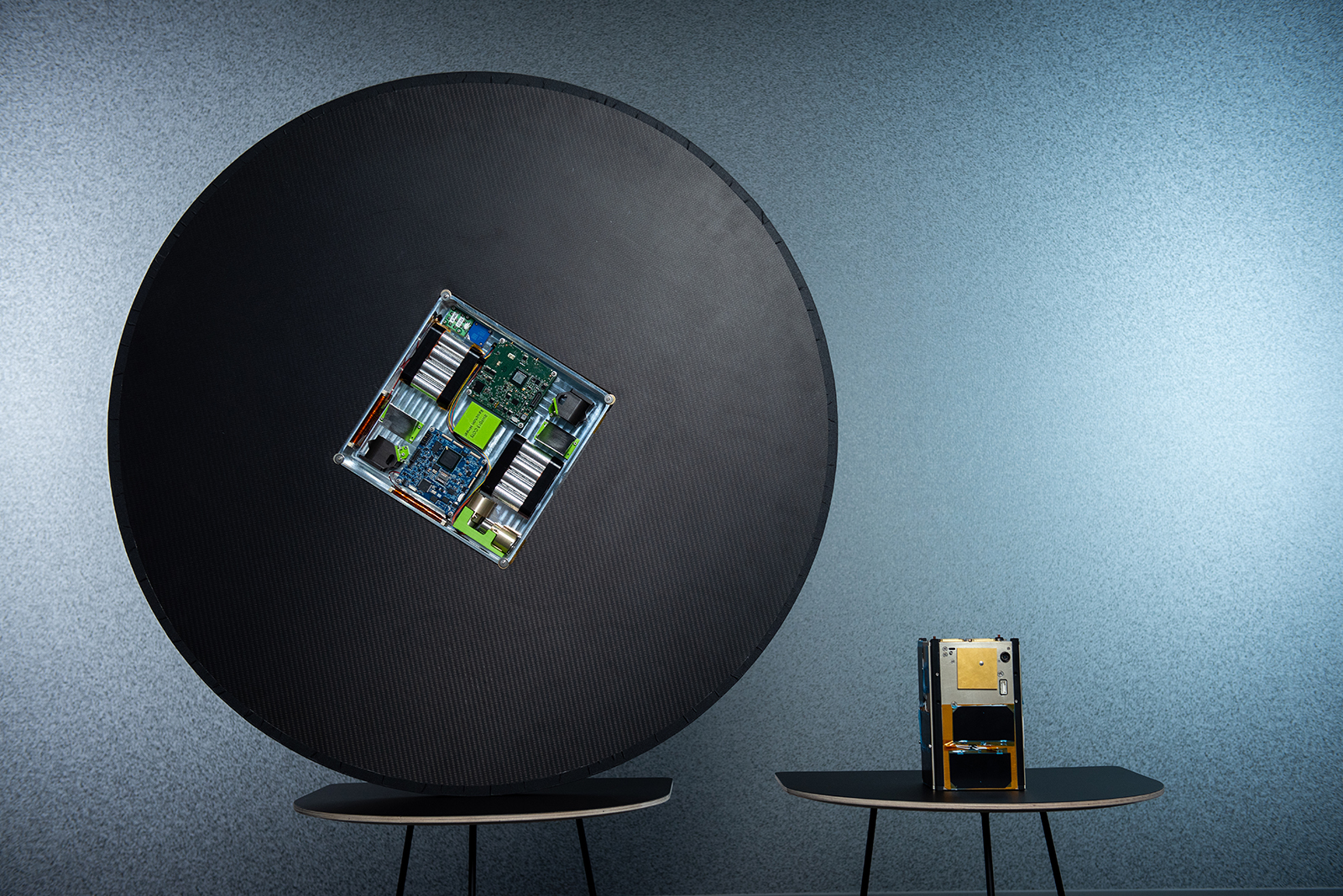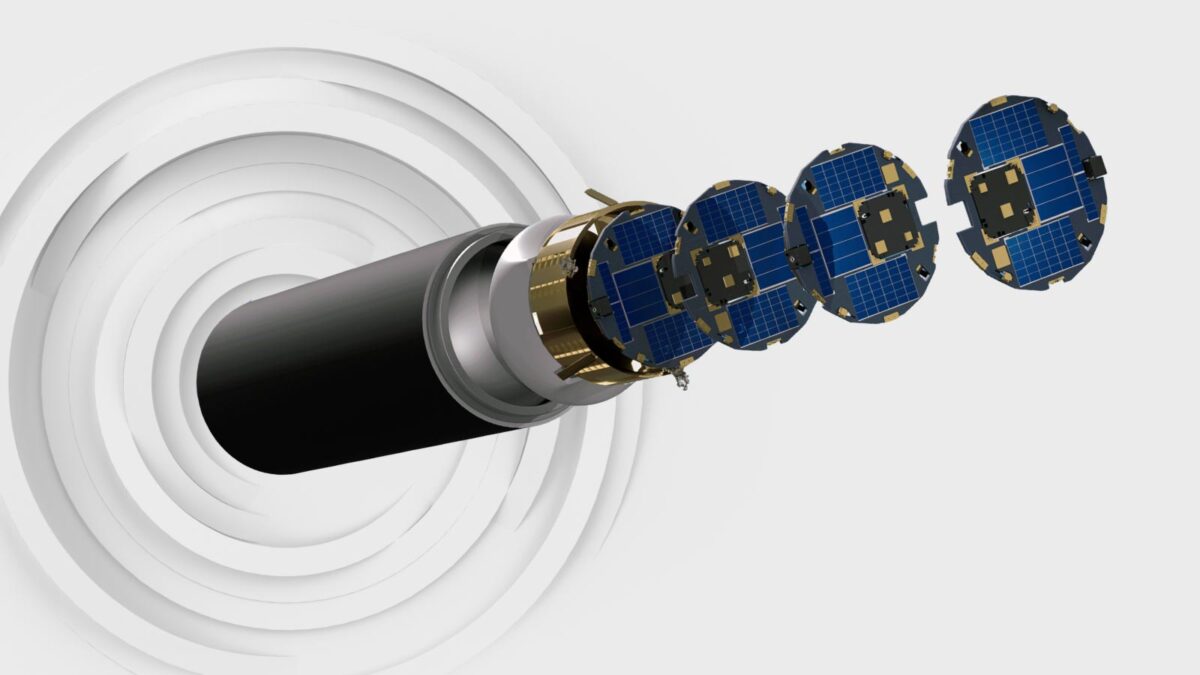A new shape for small spacecraft
By Paul Marks|March 2024
Paul Marks looks at the origin and promise of DiskSats, the flat, circular satellite format that’s edging its way toward reality.
In 2025, the payload fairing of a small launch vehicle is scheduled to be jettisoned in low-Earth orbit to reveal a curious-looking cylinder. Inside that aluminum can, four flat, circular satellites — each a meter in diameter and only 2.5 centimeters thick — will be stacked like pancakes, separated by contact points between them. If all goes as planned, a geared mechanism will elevate each satellite to the top of the can and hurl it out into orbit.
This won’t be some orbital publicity stunt by the International House of Pancakes but the first demonstration of the DiskSat concept — small, flat, meter-wide satellites built to a format that could soon join cubesats among the leaders in the small satellite field. The carbon composite and aluminum chassis structures of the four that are planned for the test launch next year arrived in January at the Aerospace Corp., the federally funded research center in El Segundo, California, that investigates new technologies mainly for the U.S. military and intelligence community.
There, in 2020, senior scientist Richard Welle had something of a Eureka moment when trying to figure out how to squeeze much more power out of small satellites, and perhaps launch many of them at the same time. Welle — whose specialisms include microsatellite solar power, advanced materials and propulsion — happened to be looking at some samples of rectangular composite material on a table in his office when, he says, it dawned on him that a flat circular satellite could be a great way to achieve much larger solar panel surface area.
“Sometimes it pays to just sit in a quiet office and think,” he told me by email.
Welle dubbed the envisioned satellites “DiskSats.” Weight would be kept down by starting with an aluminum honeycomb core, and laying down carbon- fiber-reinforced plastic composite over it. This composite would create a substrate for the solar panels and protect the payload circuitry inside the satellite.
Further advantages would come from this geometry: Constellations of disk-shaped satellites could be stacked snugly inside rocket fairings (with or without dispensers) to use volume that today is wasted when cubesat dispensers of various sizes must be squeezed inside these cylindrical fairings. Also, the solar panels could be installed on the surface on each side of the disk, therefore generating more power for a greater variety and size of payloads, including those that need a direct view of space or exposure to it.
As valuable as cubesats have proven to be, “Due to their small size, there’s certain applications where the laws of physics mean you can’t necessarily perform a particular mission,” says smallsat architect Catherine Venturini, a collaborator of Welle’s at Aerospace Corp.
The Eureka moment for Welle, who’s since retired and moved into consulting, came when he was tasked with investigating the potential for a mission concept involving designing and deploying large numbers of cubesats in LEO. He quickly realized the spacecraft would not have enough power or enough surface area to host the antennas and equipment that needed exposure to space.
“We needed a satellite with a low mass, a large surface area for power and radio frequency aperture, and capable of being launched in large numbers from a small launch vehicle – such as the Rocket Lab Electron,” Welle says. “It was obvious to me that the mission could not be done with cubesats, and the disk seemed like a good alternative. Once the idea was in place, it became obvious that the disk had advantages for many missions beyond the original study objective.”
It was not immediately obvious to everybody, however.
“As with any new idea, the reaction was mixed – some thought it couldn’t be done, some thought it provided no value. But fortunately there were enough people who thought it both workable and useful, so we got the support we needed to put together a demonstration mission,” he says.
The four prototype DiskSats are to be dispensed from an as-yet-undecided launcher, but possibly a Rocket Lab Electron, for the U.S. Space Force, no earlier than April 2025. The project is run by Aerospace Corp. in collaboration with NASA’s Space Technology Mission Directorate, with Space Force planning to run the launch and orbital operations under an agreement with NASA.
The impetus for that mission stems in no small measure from the sheer enthusiasm for it from Roger Hunter, program manager for the Small Spacecraft Technology Program at NASA’s Ames Research Center in California.
“I was intrigued,” Hunter recalls of first hearing about the DiskSat concept from Welle. “Some people come up with crazy ideas, and a lot of people are dismissive because they’re hampered by culture. In many cases, change is hard for some people to embrace. But when Rich Welle came to my office and he got his DiskSat idea up on the whiteboard, I could see a lot of applications for it. And I have a lot of students right now who want to get their hands on a DiskSat as soon as possible to see if they can enable some of their ideas on orbit, too.”
(And he has, he says, further “hare-brained ideas” to discuss with Welle.)
DiskSats could prove attractive to mission planners currently wrestling with the limits of cubesats. A single unit, or 1U, cubesat measures 10 centimeters x 10 cm x 10 cm. A 6U cubesat, a popular size, is about the size of a shoe box, at 30 cm long, 20 cm wide and 10 cm high.
“Very few CubeSats larger than 6U have flown, and none have been larger than 16U,” Welle and colleagues wrote in their 2021 paper, “The DiskSat: A Two-Dimensional Containerized Satellite” at the Small Satellite Conference in Logan, Utah. But a 1-m-diameter, 2.5-cm deep DiskSat instantly gives users a super-sized smallsat volume — equivalent to a 20U cubesat, yet with a structural mass of only 3 kilograms. The reason it’s so light? The interior chassis structure is lightweight anodized aluminum honeycomb, sandwiched between carbon fiber panels made from a space-proven, low-outgassing composite and epoxy formulation.
And because the spacecraft is a flat disk, readily available cubesat subsystems can be installed around its surface wherever the operator does not need a solar panel or antenna, Welle says. At least initially, Aerospace Corp. plans to install the avionics in a set-aside 25 x 25 cm square area, with mission-specific applications dotted around the disk as and where they are needed. Having those components distributed around the disk presents another major benefit: Troubleshooting before launch is easier.
“When you have a cubesat with its small volume, all your circuit boards and subsystems are stacked up inside it, so it’s hard to get in to replace a board or do testing,” says Venturini. “But with a DiskSat, you’ve got this large disk, and you can lay out your circuit boards and everything kind of flat. So it’s also really great for testing and integration.”
Or as NASA’s Hunter puts it: “When you’re engineering a cubesat, if you have it on the ground and something goes wrong, you’d say, ‘Oh, God, I gotta pull all my cables and all the wires out.’ You just won’t have to do that with a DiskSat. It’s like plug-and-play with Legos on top of the spacecraft; it’s all much more accessible.”
A further benefit of this distributed approach is the increased ease of thermally balancing the spacecraft — an important factor with the Enpulsion Nano indium-ion electric thruster, developed by the European Space Agency, that will propel the DiskSats, melting indium at 170 degrees Celsius on one edge of the ship’s circumference.
“There’s a lot of heat,” Venturini says. “We’ve added some passive thermal techniques to the DiskSat to compensate for flying that unit. So we took that into consideration for our thermal design.”
But that design is not set in stone, she cautions. The next one could have a different design, depending on the mission “or what we’re trying to demonstrate.”
Beyond the benefits of more real estate, “DiskSat immediately addresses one of the issues we’re trying to improve upon, and that is power,” says Hunter. Venturini says more typical power levels for a 6U cubesat range between 20 to 50 watts, whereas a DiskSat can carry enough solar panels on both sides to generate 200 watts — about double the power of most cubesats.
No one plans to demonstrate all that on the 2025 mission. Hunter wants to prove that what he calls the DiskSat “bus” works well, more than anything else. It’s important, he says, that any other payloads NASA Ames or Aerospace Corp. run on the DiskSats do not interfere with that central aim.
“After we prove DiskSats work, we want to build a spacecraft that dispenses a huge array. So you can have a communications relay station with the moon or interplanetary space, or this could be a fundamental aperture that you would use as a large telescope,” says Hunter.
He also envisages a curious type of cosmic “whip aerial” being possible for some communications applications: Wrap it around the edges of the DiskSat a few times, he says, and it can ping out a self-unfurling lengthy antenna once on orbit.
On the topic of debris, the NASA team plans to find out through the 2025 demo how quickly a DiskSat might be deorbitable by flying it “face-on” into the draggy, ultra-low-density air in LEO. This could involve flying two DiskSats edge-on and two face-on, then comparing their velocities. The maneuvers could determine whether flying the spacecraft edge-on is the best way to keep them on orbit longer, Hunter says.
Even without attitude control, a DiskSat might not constitute debris for long, says Venturini. “We’ve done some analysis that if it’s just tumbling, it’ll deorbit very, very quickly. So even tumbling can have a significant impact on deorbiting” — probably, she says, because the spacecraft would intercept a lot of draggy molecules once per turn of the tumble.
But talking about orbital demos is academic unless the DiskSat dispensing system can be perfected and made reliable enough for the rigors of orbital flight. “We have to flight qualify the dispenser, and the engineering model is looking pretty good. We’re making some good progress on the dispenser,” says Hunter.
The spacecraft are coming together fast, too, after the January delivery to Aerospace Corp. of the first four DiskSat carbon fiber and aluminum chassis structures from its contractor, Rock West Composites of San Diego.
Ultimately, shapes other than disks could emerge to satisfy the same basic idea of using up available space aboard rockets and maximizing area and power. Welle’s patent on the idea (US 11,492,147) reveals hexagonal and square “DiskSats” as among the options, as well as larger diameter circular ones.
Though Rocket Lab’s Electron, with its 1.2-meter payload bay, is in the running as a possible launcher for the first four DiskSats, the idea is far from tied to Electron-sized rockets. “The concept is extendable to other vehicles. For example, a disk two meters in diameter could fly on the Firefly Alpha,” says Welle, adding that a “disk” that’s actually a 1-m square could fly on a conventional secondary payload adapter that smallsats rideshare on today.
Essentially, large flat surfaces of many shapes and sizes could be leveraged to boost satellite solar power and aperture. “Just as most CubeSats are not actually geometric cubes, a DiskSat does not have to be a geometric disk,” Welle says. “The final shape will depend on the mission needs and the launch vehicle constraints.”












